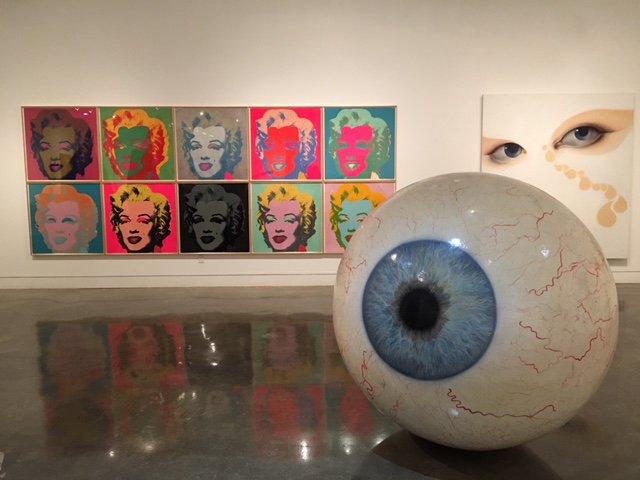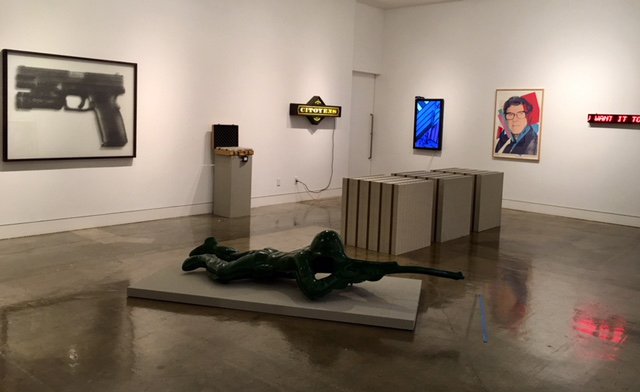POP! Selections from the Frederick R. Weisman Art Foundation




Date: September 4, 2018 – October 13, 2018
Curated By: Billie Milam Weisman
Venue: Santa Monica College, Pete & Susan Barrett Art Gallery
1310 11th Street, Santa Monica, CA, 90401
(310) 434-3434
Exhibited Artists:
Arman, Robert Arneson, John Baldessari, Brian Bress, Les Christensen, Jim Dine, EVA & ADELE, Skylar Fein, Red Grooms, Keith Haring, Jenny Holzer, Allen Jones, L.A. II (Angel Ortiz), Roy Lichtenstein, Srdjan Loncar, Joel Morrison, Nam June Paik, Mel Ramos, James Rosenquist, Paul Rusconi, Tony Tasset, Banks Violette, Andy Warhol, Tom Wesselmann, Edward Wicklander, and Yoram Wolberger.
POP! Selections from the Frederick R. Weisman Art Foundation
When the Pop Art movement first surfaced in the mid-1950s, artists sought to challenge traditional conceptions of art-making by incorporating everyday objects from consumer culture into their work. Artists during this period transformed the icons associated with mass media, comic books, and popular culture into visual expressions that often reflected a growing societal infatuation with consumerism. When it originated, the Pop Art movement sought to ironically emphasize images representing the commonplace or kitschy elements of a given culture. Today, contemporary artists have elaborated on the traditions established by the Pop artists who created an aesthetic style that reflected the changing needs and interests of varying societies. This exhibition merges art that reflects and comments on POPular and unPOPular culture from the 1960s until the present, with selections curated from the Frederick R. Weisman Art Foundation.
One of the most notable players in the Pop Art movement—Andy Warhol—placed images from consumer culture, such as those from advertising and entertainment, at the forefront of his artistic production. Warhol's signature style lay in appropriating a diverse range of subject matter from popular culture, including in this exhibition, iconic movie stars such as Marilyn Monroe, drag queens, and commissioned portraits, which he produced in multiples via editions of silkscreen prints. Red Grooms humorously chronicles the pleasures and absurdities of American life in his colorful satiric constructions, such as Mae West Visits New England, where he portrays the popular sex symbol from the 30's, 40's and 50's in comic fashion. While Warhol implicitly engages the consumer object in its original mass-disseminated identity, artists such as Claes Oldenburg made oversized "replicas" that have a life of their own, transforming the mundane into the extraordinary. Srdjan Loncar employs the unexpected in his sculptural representations, using the medium of photography to create stacks of money, the ultimate instrument of consumerism.
Warhol wasn't the only artist to use multiples as social commentary. In the 1970s Arman created works from "accumulations" of found objects. The artist famously stated “I specialize very much in…everything.” Football Shoes, an assemblage of athletic shoes encased in a Plexiglas box, reflects on a commodity-driven throwaway society. Les Christensen takes another direction by repurposing shoes—usually tied to the ground—and allowing them to metaphorically take flight. Joel Morrison’s Alligator Shoes have a different take on footwear by merging the all-American casual shoe (in this instance, Vans) with metal studs. The artist wryly aims to form a dialogue between mainstream American culture and an alternative Punk lifestyle while preserving the "high art" medium of bronze.
The work of Keith Haring incorporates the practice of graffiti in contemporary culture into "high art." First known for his chalk drawings in the subways of New York, the artist went on to cover sculptural objects as well. Working with the artist "LA II" the miniature mannequin legs are covered with graffiti, conflating painting and sculpture, low and high art. A motorcycle by LA II shows the object taken out of the context of everyday life, transformed by art, and placed back into society by riding in the streets. Jenny Holzer has always included a public dimension in her language based conceptual work, using signs of all types—an LED sign is presented here—which display social commentary with running text of her "astringent ideas, arguments, and sorrows." Nam June Paik pioneered lighted display through using televisions as his medium. The Michelin Man Laser Robot, 1996, appropriates the familiar character logo of the Michelin Tire Company, an image seen across the country in TV commercials. These works illuminate the ways in which commercialism is articulated in the public domain through language and technology.
Recently old issues have come to the foreground as more un-POPular than POPular in such works that portray women as sexual objects (Grooms & Wesselmann); or, the controversy over "THE RIGHT TO BEAR ARMS" and gun control (Baldessari, Lichtenstein, Rusconi, & Wolberger). Although they were conceived for different reasons, they are used here to reflect POPular and UN-POPular sentiment; Consumerism, Money and Fashion (Loncar); Media popularity with music stars, movie stars and supermodels (Grooms, Warhol & Wicklander). The works on view demonstrate the conceptions of Pop Art as they emerged in the 1950s and 60s, as well as the ways that contemporary artists today have extended and elaborated upon visual representations of mass culture and consumerism. Pop artists and their successors abandoned traditions of high art in favor of creating work that is rooted in popular culture and mass media. This exhibition illustrates how the Pop Art movement’s extensive history has influenced artistic production in our present cultural moment.
